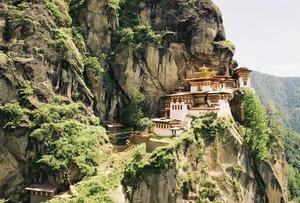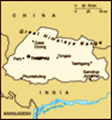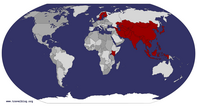Advertisement
Published: July 28th 2006

 Taktsthang Goemba
Taktsthang Goemba
Remarkably useless logistics8 am. I am tired, my vision is blurred and I want to lie down. But it is a fantastic sunny day, perfectly suited for our trip to Taktshang Goemba, one of the highlights of this trip for sure. Legend has it that when Guru Rinpoche was out flying on his tigress he saw this really nice spot for some meditation and landed on this steep cliffside some 800 meters above the Paro Valley and sat down to cleanse his mind of all thoughts. Like most places where the holy persons have meditated, it became revered and later the place for a chorten, filled with relics and artefacts. In this particular case a monastery was erected around this very chorten and it now clings to the side of the mountain like an outstanding piece of architechture. The first parts were constructed in 1684. Paying tribute to the history the monastery was named Taksthang Goemba, or the Tiger's Nest.
Save from a small path that winds its way around the mountain there is no other way to reach the place, and since the locals did not have access to flying tigers (Tiger Airways did not launch full scale operations until 2004,
and only from Singapore) they had to do with what they could carry on their backs and on packmules. Even more annoying then, that the monastery was completely destroyed in 1998 in one of those treacherous fires that have plagued Bhutanese dzongs and monasteries, and had to be painfully reconstructed again. The last time this occurred was in 1951. And although the temple sits safely from the valley being flooded loose rocks and boulders sometimes careen down the hillsides and damage the buildings.
Depending on your fitness, climbing the mountain takes around 2-3 hours. The condition of the path is a bit slippery in places, the slope is dusty and when the sun is out it gets quite hot with little shadow on offer. Every now and then you pass by cryptic and inviting signs "Use Me" attached to trees along the path. A closer exmaination reveals little holes in the ground meant for rubbish disposal and nothing else. At regular intervals you will also come across prayer flags flying in the wind. Basically there are two types, smaller lunghda flags of varying colours hanging in strings across the pathways, and tall grey manidhars erected on standing poles. The
former are generally meant to attract good luck, and the latter appear in groups of 108 flags, each group are meant to commemorate someone who passed away. The higher these flags are located, the more favour would be granted. It is not unusual to find a group of manidhar flags and wonder how on earth someone got there. Another interesting finding along the trail are piles of small rocks. Tshering explains that they are carried there by visitors, especially school children. They are making small contributions in transporting building materials for the monastery.
Fifteen minutes into the climb I start to get really tired, and I begin to wonder how on Earth I am supposed to manage this. Even though the temple is only at 3100 meters above sea level this is new territory for me and I can feel that my heart has to work a little bit extra at this altitude. Fortunately I get just the motivator I need; I see a very old couple on their way up the hill. No way I am going to fall behind! As we have climbed for some thirty minutes we catch the first good glimpse of the monastery, and
Tshering is encouraging me by saying we've covered half the distance already, and I am stupid enough to believe him.
The monastery is not alone on the hill, there are a few smaller buildings and temples situated on the same mountain, some further up the hills. It looks very picturesque, and a nightmare to have to climb down to buy your groceries. After something like one and a half hour into our hike the path levels out and we pass some small dormitories for monks and a small mountain alcove which is another famous meditation spot. Tshering explains that monks meditating sometimes stay out in the forest for three months, three days and three hours, during which they are to meditate and have a minimal intake of food and virtually no sleep. We are getting closer to the monastery now and meet up with some locals at a small lookout point, almost level with the monastery. That's when I realize that the path ahead is going downhill, and then up again. Oh joy...
There is a caretaker with a walkie talkie present, and he informs us that a big boulder fell on the cliffside next to the pathway

 Warehouse, Bhutanese style
Warehouse, Bhutanese style
Future construction and renovation materialyesterday. That's wonderful to know. The last stretch will cross a small waterfall over a small bridge before introducing one last climb to the monastery. At least there are stairs carved out of the rocks. Tshering explains that it is said to be granting the visitor more merit if you run up the last hill from the bridge to the monastery. Ok, that can't be too hard, let's do it I suggest. We take a little break at the bridge before starting to jog up the stairs. After twenty meters I have had enough, and accept my failure. When we finally reach the temple we just stand around panting like crazy. To visit you need a special permit, which we have prepared and pass to the guard. At the monastery we visit the caretaker, a young monk who shows us around three of the temples inside the monastery, all exquisitely decorated with the typical manifestations of the deities and gurus.
As our tour finishes and we prepare to go back down I inquire about some of the other temples on the hillsides, and although Tshering says they are not open for visits we could still continue uphill and have

 Halfway there?
Halfway there?
You've got to be kidding me.a closer look. Sounds good to me! The first one is a tiny building squeezed in between the cliffs next to the waterfall. It is easy to reach, even though the stairs are absurdly steep and slippery. The next one is further up the hill on the other side, partially hidden by the vegetation. The path is easier though and it is only a matter of twenty minutes or so before we reach it. Here is a small temple where we meet a monk who is just coming up to meditate in a cave beside the temple. There are some small buildings even further up the hills, but the path is pretty tricky and we are beginning to get tired. We decide to head down for lunch.
Of course down means having to go down, and then up again, and then really down. There is a small building halfway up the mountain where tourists are served lunch and we have our meal together with an American group that have been visiting as well. The food is tasty and mainly consists of rice, vegetables and some chicken meat. The last leg downhill goes fast as we slide down the hills
and the walking stick wielding Pennsylvanians. "Look, there's that guy from Switzerland again". By this time the pathway has become more busy, and a number of local people are seated along the hillside and selling souvenirs, and I wonder what this place will look like in five years time, as tourism gets a better foothold.
Once down at the starting point we meet up with our poor driver who has waited for some seven hours. We hop into the car to make a visit to the Kyichu Lhakhang, a temple responsible for fettering the left foot of a giant demoness lying all over the region. The plan to bind this giant creature by building 108 temples was devised by the Tibetan king Songtsen Gampo in 659. We are lucky to arrive today, as the temple will be closed starting tomorrow due to the upcoing religious festivities. Once again we bump into some of the Americans, and I wonder if we will be criss crossing paths throughout the entire stay, but unbeknownst to me, this would be the last day I saw any of them, as they headed eastwards.
On the way to the Lhakhang I ask our driver
to stop by one of the hanging bridges that cross the Paro Chhu river for a closer look. We are bumping into some shy school children who start laughing hysterically as we trade hellos for kuzu zangpo las. Finally late in the afternoon we begin the journey to the capital, where we will spend the rest of the trip. The trip by car takes roughly an hour and a half along narrow serpentine roads through the Paro valley. There are roadblocks between provinces, and as a traveller you would need to make preparations if you want to travel around, spontanity is not the best method for seeing Bhutan.
When we arrive in Thimphu darkness is about to fall and the weather has become a bit gloomy and cloudy. The hustle and bustle of the city makes me miss the slower pace of Paro. I am prompty taken to the Yeedzin guest house which will be my home for the coming nights. At first sight I find the room rather dreary, not at all up to the same standard as my room in Paro. However, the staff is friendly and I have been fortunate enough to get a room with
a TV, which is not part of the normal room equipment, and thanks to Tshering I get to keep it for my stay.
As my companions see me off for the night and head to their own places I decide to have a look around on town. I need to stock up on some foods and if possible a SIM card. Just by chance, as I leave the hotel, one of the staffers is going back home and offers to take me to a shop were I can get a card. Finding the shop is easy enough, but the procedure for obtaining the card is a bit cumbersome. I need to fill out a formal requisition with Bhutan Telecom and I need to attach a copy of my passport to it. One of the staffers takes my passport and speeds out into the night as I watch in amazement. Finally I receive a SIM card though, and it actually seems to be working alright.
There are plenty of small shops around the area where I stay and I stock up on some snacks and juice and get Indian rupees in exchange. Walking back the neighbourhood is pitch black,
and I find myself a bit lost until stumbling into the proper road back to the hotel. I try giving my local friend Jasu a call, but instead reach her sister who informs me that she is out of town and gives me another number to dial, however that only results in a message that the phone seems to be switched off. Again it has been a long and exciting day, and I get into bed much too late again. Tomorrow will be the start of the Thimphu Tsechu festivities, and we are supposed to start early. Oh dear...
Advertisement
Tot: 0.062s; Tpl: 0.016s; cc: 10; qc: 19; dbt: 0.0376s; 1; m:domysql w:travelblog (10.17.0.13); sld: 1;
; mem: 1.1mb
























Sharon
non-member comment
I was in Bhutan in July of '04 and this past summer we hosted 6 Bhutanese kids and their chaperone in Telluride as part of an exchange/homestay program. Love your blog. Brings back all the wonderful memories of this incredible country. I sent home extensive journals, but had no blog. Thanks for yours. Beautiful pictures.